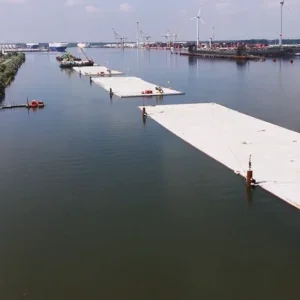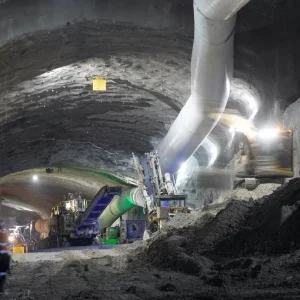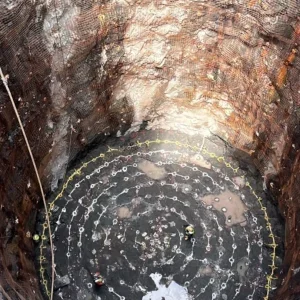To improve the speed and efficiency of the rail network in Israel, a project is under development to construct a new, faster link between Tel Aviv and Jerusalem.
Works are underway at many locations between the cities and have been for the last few years with two of the three stages of the scheme already completed. The third stage includes various excavations and underground constructions for tunnels and stations and work on most sites is underway.
The rail link was studied for many years to be a replacement to the older, slow line between Jaffa and Jerusalem, which was built in the late 19th Century and also the first main rail route in the area.
The new line is being developed by Israel Railways and is to be an approximately 60km long, double-track route with a design speed of 160km per hour. In the western portion of the rail link the route generally follows that of the adjoining highway. It is planned that the line, which rises at a maximum grade of 2.5 per cent from Tel Aviv to reach an elevation of 740m a.s.l. in Jerusalem, will be for passenger transport only.
But in additional to some technical challenges there are also political sensitivities on parts of the route which are near some villages, some within Israel’s borders and others on the West Bank demarcation line between Israel and Palestine.
Planning and initial stages
In the first stage of the scheme, construction of the rail link began with the section from Tel Aviv inland to Ben Gurion Airport, including two tunnels. One tunnel was constructed by cut and over and required a temporary diversion of Road No.1, the main highway between Tel Aviv and Jerusalem. The other tunnel was mined in clay using sprayed concrete lining (SCL) below the Shapirim Bridge near Beit Dagan. Both tunnels were designed by A. Rozen Engineering.
The second stage of the rail link construction took the line farther east, from the airport to the city of Modi’in. Five tunnels were built in this mid-section of the route, including two at Anabe and the other near Modi’in. One of the excavations was by cut and cover, on the 1.6km, longest of the tunnels. The majority of the tunnels were mined using SCL and designed by A. Rozen Engineering.
Construction of the Anabe tunnels was performed by contractor Linom, a bridge contractor becoming more active in tunnelling. The cover to the tunnels was relatively shallow below the main road and forepoling was employed, notes Arnon Rozen of A. Rozen Engineering.
Project manager on the works – which included Israel’s first, and so far only, underground station – was Hana Stern of Dana Engineering. The Mod’in Central station is constructed 30mbelow the surface.
However, the real weight of the tunneling work on the rail link is in the third stage, concentrated in the eastern portion of the route closest to Jerusalem. The total length of the main running tunnels is approximately 36km.
Preliminary design work was done in 2000 by Hasson-Yerushami Engineers, as prime designer. The tunnel design work was undertaken by A. Rozen Engineering, and at that stage – a decade ago – the concept was to build three twin tubes and an underground station, with an access tunnel, in Jerusalem.
The present design of the third stage of the rail line was performed by Amy-Metom, as prime engineer. Split into four sections (A-D), the rail link has five tunnels in sections B-D. The tunnels are Nos. 1, 2, 3, 3A and 4 – the latter tube not being the longest but having the most complicated layout as it links into the new underground station being constructed in the city.
Tunnels in the east
The tunnelling works in the third stage of the fast rail link involve a range of bores of radically varied lengths and employing different construction methods, from TBM to mining with SCL.
Most of the route underground will see trains travel though the twin tube, singletrack tunnels of Tunnels 1, 2, 3 and 3A. The only single bore, double-track tunnel on the project is Tunnel 4, which is 2280m long and the farthest east of the tubes taking its approach to the new Binyanei Hauma station, in Jerusalem.
The lengths of the tunnels are 3,544m, 1180m, 11,600m and 820m long, respectively. The only single bore, doubletrack tunnel on the project is No. 4 which is 2280m long, is the furthest east of the five and approaches the new Binyanei Hauma station in Jerusalem.
Excluding cross passages at approximately 250m intervals, the total length of the main running tunnels in the third stage of the link is approximately 36.5km with almost two-thirds to be driven by TBM.
Various joint ventures between Israeli and international firms have been awarded the construction contracts covering the five tunnels:
• Tunnel 1: JV of local firm Menrav and Russian contractor Mosmetrostroy.
• Tunnels 2 and 3: JV of local company Shapir and Italian firm Pizzarotti.
• Tunnels 3A and 4: JV of local contractor Hofrey Hasharon and Max Bogl.
Two companies are responsible for the principal tunnel designs – A. Koren for Tunnels 1 and 2, and A. Rozen Engineering for Tunnels 3, 3A and 4. However, the contractors on Tunnels 1 and 2 have modified the design within their design-build contracts, and the design of Tunnel 3, which will have the TBM drives, was also altered by the contractor, notes Arnon Rozen.
The project manager and site supervisor for Tunnels 1, 2 and 3 is Eldad Spivak of Spivak Engineers. For Tunnels 3A and 4, Hana Stern of Dana Engineering is providing the project management and site supervision services.
Separately, the JV of Horey Hasharon and Max Bogl is working on excavation of the two lower station, large-span caverns that are connected to Tunnel 4. The upper level excavation, elevators and ventilation shafts and the concourse cavern are being built by Israeli contractor Ramet.
Tunnels 1, 2 and 3
The alignment of Tunnels 1 and 2 pass through mainly marly formations with chalk and soft limestone, whereas the rock to be met in the other three tunnels is harder, including limestone and dolomites, explains Spivak Engineers.
The greenlight for construction of Tunnel 1 was recently given, and the JV of Menrav and Mosmetrostroy plans to excavate the twin tubes by TBM. The contract is the last on the route to begin excavation.
For Tunnels 2 and 3, the contracting JV – operating as Shapir Pizzarotti Railways (SPR) – has a 44-month basic programme to construct the twin tubes, which are about 15m apart and will have a total of 46 cross passages.
Geology along the alignment of the tunnels comprises limestone and dolomite of the Cenomanian-Turonian era, and the bedding dips generally at about 20 degrees from east to west. However, there are some karst formations expected along the route. Cover to the excavated crown will range from 7m up to 40m for Tunnel 2 and 270m for Tunnel 3.
Given the semi-arid climate it is expected that groundwater challenges will not be present except, possibly, for a few potential but relatively small perched water tables along the alignment of Tunnel 3.
Tunnel 2 is already under construction using SCL for about 900m of its length, and in the portal areas the excavation is by cut and cover. The mined bores have basically a horseshoe-shaped cross-section and advance with full-face excavation. The excavated width is approximately 9.3m with a primary lining of approximately 250mm of shotcrete, steel ribs, and mesh, as required.
In the soft broken chalk/marl of the west portal area the contractor used both hydraulic hammers and rotary heads fitted to an excavator to advance the drives. Once the drives had progressed into limestone the contractor employed advanced the face by drill and blast excavation using a Sandvik rig.
Following placement of drainage and waterproof membranes on the primary lining the tunnel will be completed with placement of insitu concrete for the secondary lining.
Once Tunnel 2 has completed it will be the conduit through which will be transported the two Herrenknecht TBMs that will be used to bore the twin tubes of Tunnel 3 – the longest tunnels on the entire rail line. This is expected to happen in early 2011.
The pair of 10.04m diameter double shield TBMs will each be used to drive up to 10km, or approximately 86 per cent, of the tunnels. The refurbished shields are to be launched at the western portals and then be dismantled underground in chambers prepared about 1.6km from the opposite end by drill and blast drives.
But negotiating the suspected karstic voids is expected to be the biggest construction challenge on the contract, especially any that may be below or near the TBM invert areas.
The remainder of the Tunnel 3 tubes will be constructed by SCL except for the portals, which will be done by cut and cover. Over burden.
Cross passages along Tunnels 2 and 3 are spaced at approximately 260m intervals, and have excavated dimensions of 5.8m wide and 5.8m into the horseshoe-shaped roof. Detailed design work is still continuing to establish the final, completed dimensions of the cross passages. The majority of the cross passages – 43 – will be built to linked the parallel tubes of Tunnel 3.
Tunnels 3A and 4
The contractor JV of Hofrey Hasharon and Max Bogl has a 48 month period for excavation and lining of Tunnels 3A and 4, and the schedule calls for the underground civil works to be completed by March 2014. Work on Tunnel 3A commenced in September 2010 and excavation of Tunnel 4 is due to begin in January 2011, explains project manager Dana Engineering.
All the tunnelling works are to be undertaken SCL. Geology along the alignment of Tunnel 3 comprises chalk and limestone and the overburden is up to 65m. The cross section of each tube is approximately 8.65m by 8.2m. Each of the primary and secondary linings of shotcrete are about 150mm thick.
Tunnelling plant on the project includes an Atlas Copco Rocket Boomer L2C with two booms and a Schaeff ITC 312 roadheader. The contractor is driving from the east end only of Tunnel 3 due to the tubes running below a large national park. It has, therefore, one set of equipment working across the parallel north and south drives which enables excavation to proceed in one bore while concreting works are underway in the other.
However, while the average planned advanced rate is about 35mper (6-day) week across both drives, poorer ground conditions have meant progress has been less so far. But full face excavation is being achieved.
Dana Engineering also notes that the payment approach is different for the latest tunnelling works on this fast rail link. Instead of the traditional system of payment based on quantities of materials, the new system is based on payment per metre of advance – the rate varying up and down with poorer to better ground conditions.
There are four basic support designs set under the system for ground conditions varying from fair to poor then very poor and the worst being extremely poor, based on the Barton rock classification system, notes Dana Engineering. Any debate between contractor and project manager/supervisor can call on the designer to settle the matter – in this case Arnon Rozen.
Tunnel 4, though, is both longer and a much more complex tunnelling challenge with the single tube starting on the ramp that supports Road No. 1, and therefore early works in 2011 will include a shallow passage below the highway.
The layout of the tunnel, running under Jerusalem, will also include four emergency connecting tunnels, each with its own utilities, and also a large access tunnel. With a major portal and five small tunnels the tunnelling works could see three or four faces being worked on simultaneously. Tunnel 4 will bifurcate on the approach, approximately 80m below the surface, to the caverns of the new Binyanei Hauma Station.
Map of the fast rail link under construction in Israel Initial groundbreaking at second tube on Tunnel 3A Spoil removal with a Schaeff ITC 312 loader at first tube of Tunnel 3A Drill and blast work underway in Tunnel 3A Excavation and support inspection in Tunnel 3A Excavation in an Anabe tunnel during an earlier stage of fast rail link construction







